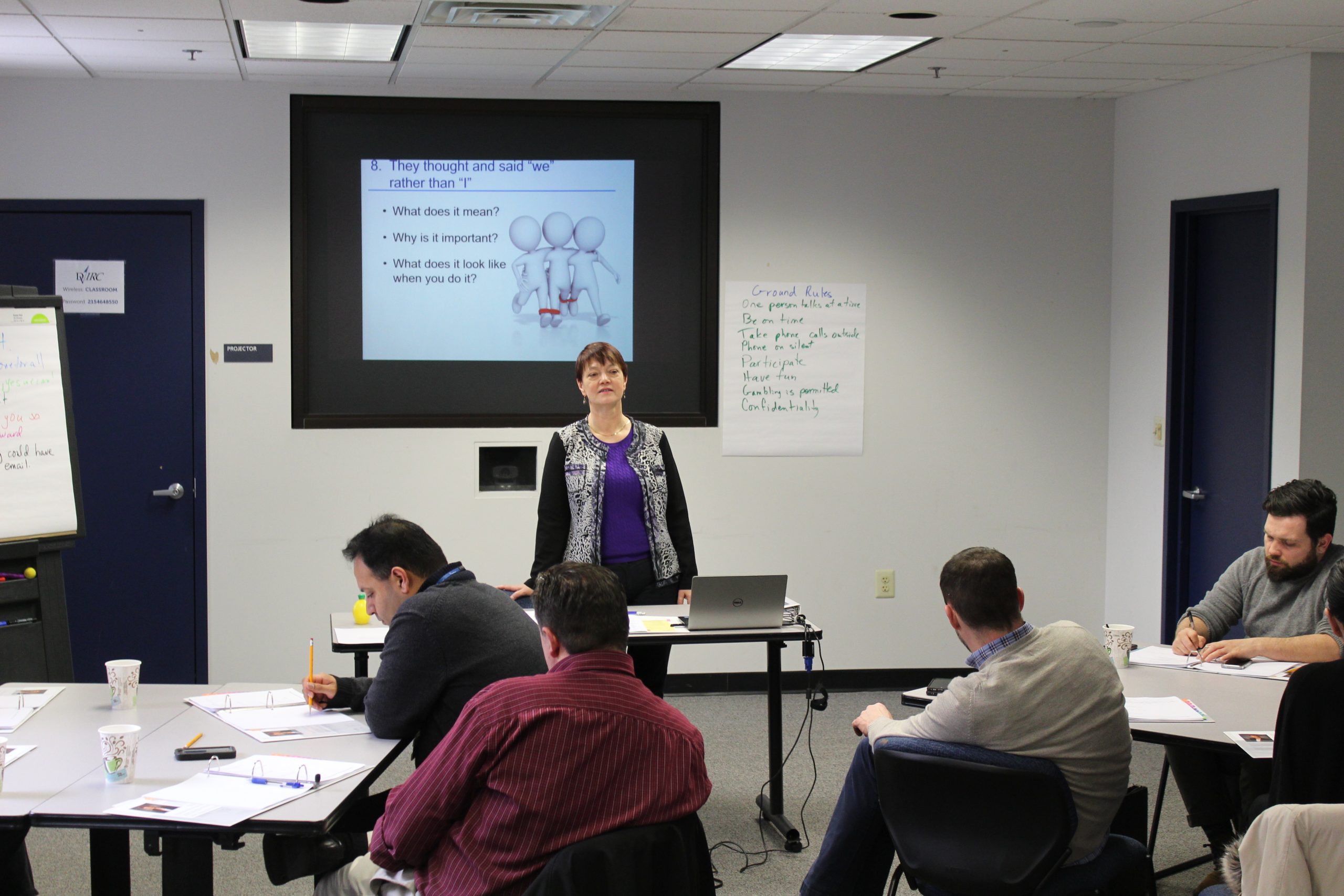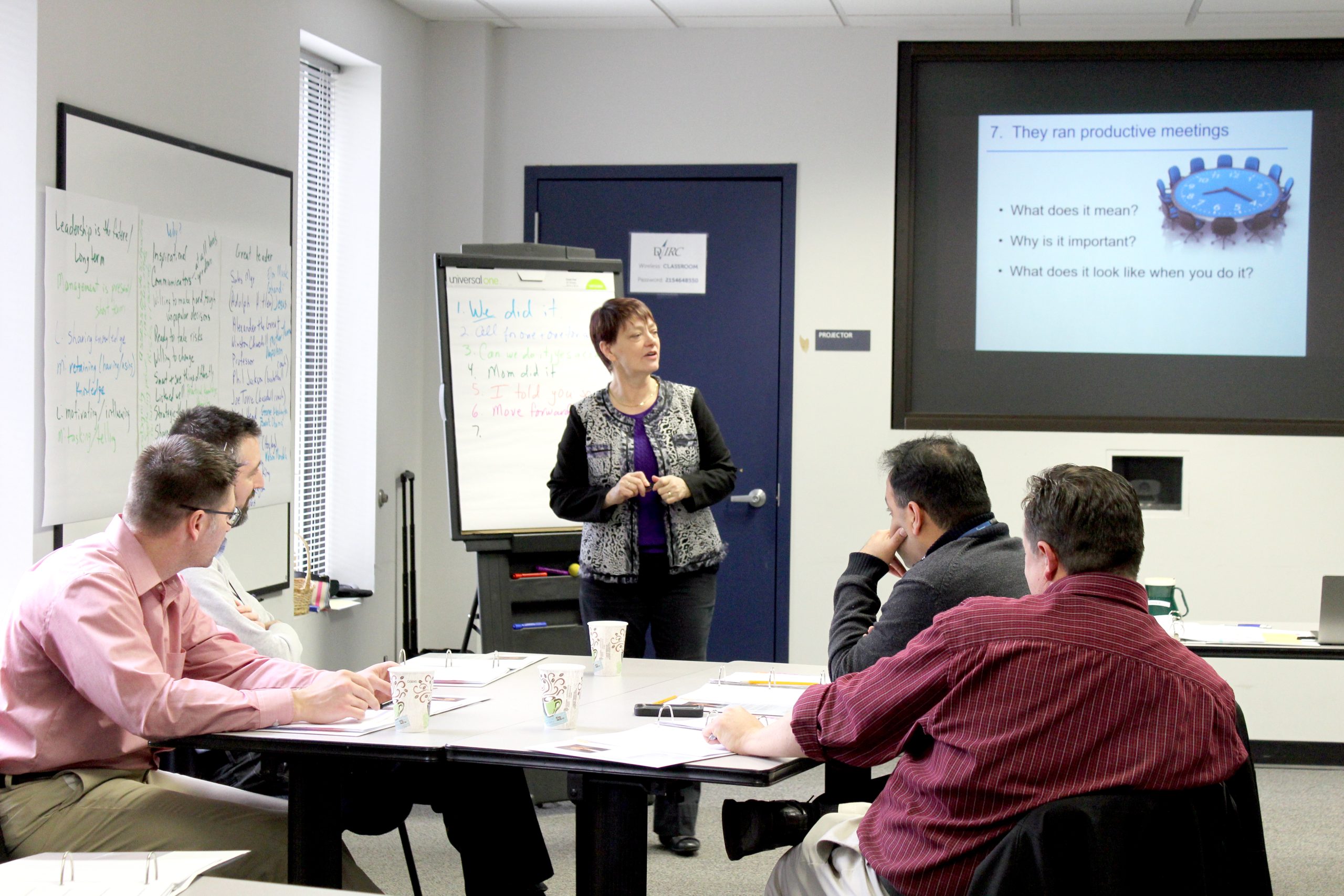
Over the past decade, Donna Butchko—DVIRC strategic partner and President of Leadership Systems, Inc.—has delivered countless leadership training and workforce development training courses. As a leadership expert, her engagements with first-time managers, supervisors, C-suite executives, and everyone in between, have enabled her to shape the leadership habits of hundreds, if not thousands of area professionals, with a particular expertise in manufacturing.
DVIRC sat down with Donna recently to talk about the finer points of leadership training, learn a bit more about her background, and see what she has learned after more than ten years as our in-house leadership guru.
DVIRC: Tell us a little about your professional background.
Donna: I got my undergraduate degree in chemistry from Rutgers, followed by a master’s in organizational dynamics from the University of Pennsylvania. My undergrad program included work with the Leadership Development Institute at Rutgers, which at the time was the country’s only leadership study program at a research-based university.
MBAs were the hot ticket at that point, but I knew that wasn’t what I wanted. It wasn’t my dream to be a CEO or CFO, and when someone told me about the [Organizational Dynamics] program at Penn, I saw that as the other side of the MBA coin. It was an opportunity to help people work together.
I’ve studied leadership ever since I was an hourly employee. Like so many of us, I started as an hourly worker at a small manufacturing company, pretty quickly working my way to front-line supervisor. If I can be honest, though, I was a pretty awful supervisor.
That changed one morning very early in my career, though. I was part of a very traumatic experience in the workplace, and without going into details, it was obvious that day—I was in my late 20s—that even though most of my coworkers were older than I was, they were looking at me to take control.
That’s when I realized that leadership is not about doing what you think you should do, or what you want to do. It’s a matter of doing what people need you to do.
Inside I was screaming “I’m just a kid who doesn’t know anything!” I had no choice but to step up and do what people needed me to do until the plant manager arrived. That was the day I moved from being a supervisor to being a leader.
Around the same time, I recognized that good training makes a world of difference. I continued to make training a bigger and bigger part of my responsibility, and after I eventually became manager of manufacturing, I opted for a lateral move to focus on training.
I eventually moved on to some larger companies, ultimately spending time at Pfizer, Hoffmann–La Roche, and Merck. I picked up some great “train-the-trainer” exposure through those years, and along the way I helped people develop the soft skills they need, focusing more in that area than just on-the-job skills.
DVIRC: Let’s define workforce development in your terms. How would you describe it to someone who may be new to the topic?
Donna: We actually talked about this at a training session recently. It’s the tasks you need to complete to do your job, but it’s more than that, too. It’s going beyond the job tasks and functions to figure out the kind of employee someone needs to become. When an employee knows what to do, they’re motivated and engaged, they’re eager to learn more, and they’re happy they took the job. That’s the best front-line worker.
As for supervisors, they actually have the potential to make the most difference in an organization. They touch the most people. If they can develop good skills in their direct reports, their job just got easier. Companies spend lots of money on executive coaches for C-suite people, but they don’t realize if they invested in those same workers when they were supervisors, they wouldn’t need to undo all those bad habits.
DVIRC: How did you come to specialize in leadership/workforce development? What initially inspired you to work in this area?
Donna: Even coming from a technical background, I’ve always been interested in the difference between good and bad training.
Too often we take the best technical person on the floor or in the engineering department and promote them to management. But it’s too easy to make that change without thinking about those being very different skillsets.
Especially when you’re moving from a technical area to a leadership position, the more technical, the less likely you are to have spent time developing your people skills. Engineers don’t become engineers because they like working with people, for the most part. You need to acknowledge that.
When we’re having a tough time, we want to do the things we’re good at. That’s how the frustrated technical person ends up micromanaging and trying to help with the tasks they know best. If that happens, they aren’t happy, the workers aren’t happy, and you’re wasting the talents of everyone involved. I want to help them head off those mistakes.
DVIRC: What is it about your background/education/mindset that you think makes you successful in this area of consulting?
Donna: It’s that combination—the fact that I’ve been there in the production roles as well as the supervisory and leadership roles. I think that’s why I can talk about these things. Believe me, I made every mistake you can make on the way up. If you bumped into someone who worked with (or under) me when I was coming up, and you told them I train people to lead others, they would laugh. In addition to all that experience and those hard lessons, I had to go back and get the right education to understand these things.
DVIRC: What’s the most common mistake you see clients making in terms of leadership and workforce development?
Donna: Thinking that sending one person to a class will change their culture, believing that something that isolated will make broad improvements. I had a nice note recently from a company owner about an employee who took part in one of our classes. I wrote back to thank him for seeing the need to send that person for training and demonstrating his support of the training by talking with the employee about what he was learning.
When you have that commitment all the way up the chain of command, you’ll see improvement. When the owner is asking a front-line worker how things went, and their curiosity and concern is genuine, that shows, and it reinforces those lessons and their importance.
DVIRC: On the flip side, is there a particular mindset regarding workforce development that you think sets a client up for success?
Donna: Commitment across the organization, without a doubt. My favorite thing is talking to the leadership. When they’re engaged enough to find out what their employees are learning so they can continue those lessons. That acknowledgement and reinforcement does more than one or more lessons with me.
And remember, that leadership role can come from the supervisor/lower-level management role, too. If you’re a supervisor with a bad boss, that doesn’t prevent you from creating a space for your workers to grow and flourish.
DVIRC: What do you think makes DVIRC unique when it comes to the way we approach and deliver workforce development training and support?
Donna: You have people with real-world experience. My first exposure to DVIRC was when I brought them in to Merck for some Lean training. I was struck right away that it wasn’t just textbook training. The instructor had been there. He had done these things. That brings a world of credibility.
Donna is just one of DVIRC many subject matter experts who gives client the benefit of their own, varied experience and expertise when it comes to training and consulting engagements. Learn more about how we can support your workforce development offerings or Contact us today.


